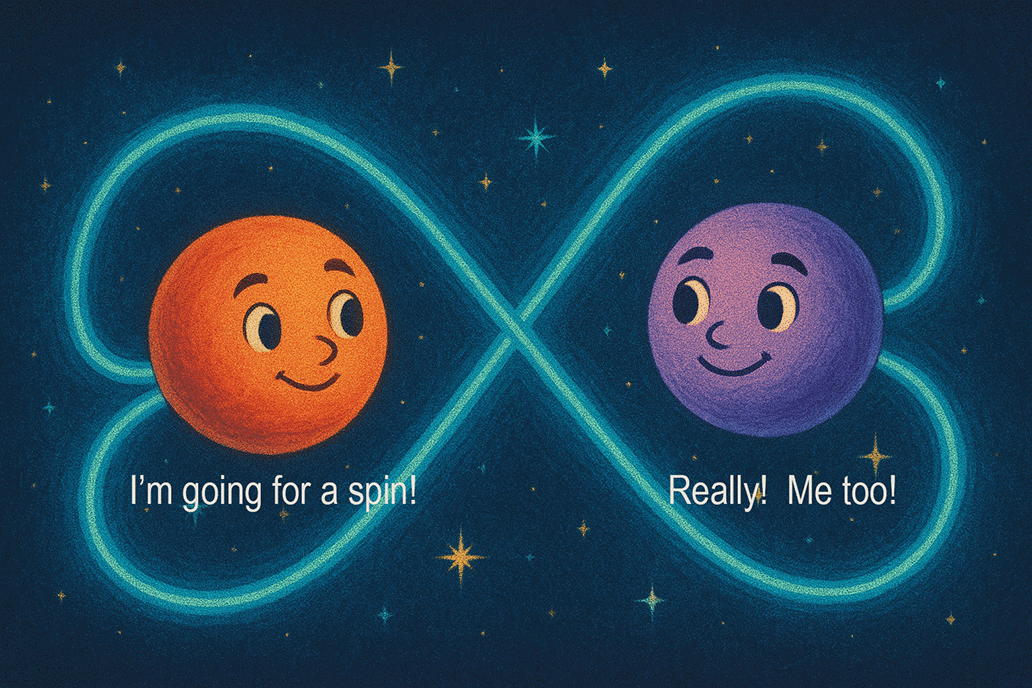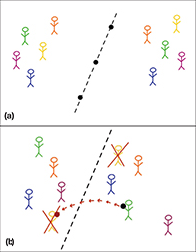Quantum Entanglement: When Particles Become Best Friends Forever

What is Quantum Entanglement?
Imagine you have a pair of magical coins that are forever connected. When you flip one coin and it lands on heads, the other coin—no matter where it is in the universe—instantly becomes tails! This sounds impossible, but it's exactly what happens with tiny particles in the quantum world through a phenomenon called quantum entanglement.
When two particles become entangled, they form an invisible connection that works instantly across any distance. Scientists have created entangled particles and separated them by hundreds of miles, yet they still "know" what happens to their partner immediately. It's like they're cosmic twins who can read each other's minds!
Key Properties of Entangled Particles
- Correlation: If two particles are entangled, measuring a property of one particle will immediately reveal the corresponding property of the other.
- Indistinguishable: Entangled particles can be considered indistinguishable. Their properties are linked in a way that they cannot be treated as separate entities.
- Distance doesn't matter: The connection works across any distance.
- Fragile bond: Observing or disturbing the particles can break the entanglement.
Einstein's "Spooky Action at a Distance"
Even Albert Einstein was puzzled by quantum entanglement. He famously called it "spooky action at a distance" because he couldn't believe particles could affect each other instantly across space. Einstein thought there must be some hidden information being passed between the particles that we couldn't detect.
But in the 1960s, scientist John Bell created a test to check if Einstein was right. When scientists performed Bell's test, they discovered something amazing: the particles really were connected in ways that seemed impossible! There was no hidden information—the connection was genuinely instant and mysterious.
How Scientists Create Entangled Particles
Researchers use special crystals or lasers to split single particles into pairs, or they cool atoms to extremely low temperatures and use magnetic fields to link their properties. Once entangled, these particle pairs maintain their connection even when separated by vast distances.
Real-World Applications
Quantum entanglement isn't just a fascinating science curiosity—it's helping create amazing new technologies:
- Quantum Computers: Use entangled particles to solve complex problems much faster than regular computers
- Ultra-Secure Communication: Messages sent using entangled particles cannot be intercepted or hacked
- Quantum Teleportation: Scientists can transfer the properties of one particle to another instantly
- Precision Measurements: Entangled particles help scientists make incredibly accurate measurements for research
Mind-Blowing Quantum Facts
- Distance: Scientists have successfully entangled particles across distances of over 900 miles!
- Speed: Quantum entanglement happens faster than light - Einstein called this impossible, but experiments prove it's real
- Tangled in Space: China has launched a quantum satellite that creates entangled particles in space
- Tangled Birds: Some scientists think quantum entanglement might explain how birds navigate during migration
- Computers: Quantum computers using entanglement could break most current internet security codes
Entanglement in Thunder Cloud Summer
Cloud's telepathic connection with Ben works like quantum entanglement! When their minds become linked, they can share thoughts and feelings instantly, no matter how far apart they are. While we can't actually entangle human brains (yet!), the science behind their mental bond is based on real quantum physics.
Just like entangled particles, Ben and Cloud's connection allows them to know what the other is experiencing immediately, even when Cloud is hidden or far away. This quantum-inspired bond helps them work together as a team throughout their adventure!
From Fiction to Science
While Cloud's telepathic abilities are fictional, real scientists are using quantum entanglement to create "quantum networks" - systems where information can be shared instantly between distant locations. Some researchers are even working on quantum internet that would use entangled particles to create ultra-secure communication networks!
Maybe someday we'll understand consciousness well enough to create genuine mind-to-mind communication. Until then, quantum entanglement remains one of the most mysterious and useful phenomena in modern physics, helping us build the technologies of tomorrow while expanding our understanding of how the universe really works.
Try it Yourself!
1. Simulate Quantum Entanglement - Entanglement Dodgeball
Materials:
- Two groups of students, each group of the same size. For example, two groups of 8 students works well.
- Soft dodgeball (don't want anyone to get hurt!)
- An open space - the gym works great!
Instructions:
- Review the rules of Dodgeball.
- Before starting the game, pair each student in one group with a student in the other group. This creates entangled pairs. As the game starts, each member of an entangled pair starts on opposite sides of the center line.
- As the game is played, entangled pairs are always in the same state as one another. That is, they are either both “in play” or both “out of the game” —the actions on one half of the pair affects the state of the other player.
- In regular Dodgeball, when a ball hits a player, that player is eliminated. In Entanglement Dodgeball, both the player who is hit and the player’s entangled partner (who is located on the opposite side) are eliminated.
- Rather than trying to eliminate all players on the opposite team, each entangled pair acts as their own team, trying to eliminate all other entangled pairs. The last entangled pair standing wins.
Here is a diagram of the game.

Partnerships are indicated by similar colors. The black dotted line separates the court into two sections. The red ball indicates the final position of a thrown ball and the red X’s indicate student elimination. (a) Starting position. (b) Elimination of the yellow pair by a yellow player being hit with a ball thrown by a green player.
What This Shows:
Normal Dodgeball games are quite random - anyone get get eliminated at any time, and only one person gets eliminated. But in Entanglement Dodgeball, players are truly "entangled," they ALWAYS get affected by their partner's game state, no matter how far apart they are. They could be in China, and they would still get eliminated if their partner got eliminated!
Activity Credit:
This activity is modeled after the activity in the paper "Entanglement Ball: Using Dodgeball to Introduce Quantum Entanglement", published in the Novemebr 2021 issue of The Physics Teacher journal.
Think About It: In this activity, we changed Dodgeball rules to help us imagine what quantum entanglement is like. What would it mean if objects in our everyday world really behaved as if they were entangled?
2. The Quantum Communication Game
Materials:
- Deck of playing cards
- Two players
- Timer
- Score sheet
Instructions:
- Player 1 draws two cards (face down) and separates them without looking at the cards value.
- Each player takes one card to opposite sides of the room.
- On "go," both players flip their cards simultaneously.
- Score a point if the cards are the same color (both red or both black).
- Play 20 rounds - normal cards will match about 50% of the time.
- Real entangled particles would match 100% of the time!
Quantum Advantage:
This game shows why quantum entanglement is so special - it creates correlations that are stronger than anything possible with classical objects!
Want to Learn More?
- Kiddle - Quantum Entanglement Facts for Kids
- NASA Science - What Is the Spooky Science of Quantum Entanglement?
- World Science Festival - Is Gravity the Hidden Key to Quantum Physics?
- TEDx Talks - Quantum entanglement explained
- IBM Quantum Computing - Learn about quantum computers